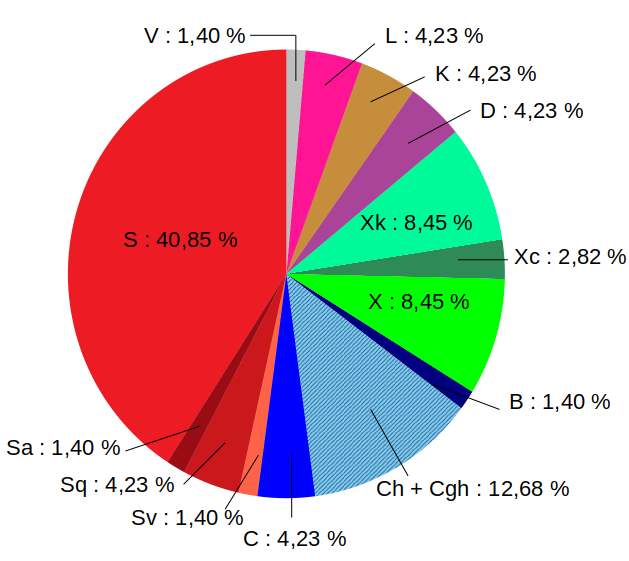A survey of Inner Main Belt planetesimals : composition and mineralogy
- 1Observatoire de Paris, LESIA, Planetology, Meudon, France (jules.bourdelledemicas@obspm.fr)
- 2Université Côte d'Azur,CNRS-Lagrange, Nice, France
- 3Lowell Observatory, Flagstaff, U.S.A
Asteroids, along with other small bodies are what is left of the original planetesimal disk from the planet-formation era. But not all asteroids that we observe today are planetesimals. Many of those planetesimals, during the history of the solar system, were destroyed by impacts, creating families of smaller asteroid fragments, which make the vast majority of the current main belt population. However, very few of these collisional fragments are actually linked to known families. The smaller are the sizes of the family members, the more numerous they are. Moreover, due to non-gravitational forces, known as the Yarkovsky effect, the members of these families move away from the original location with a velocity proportional to 1/D, where D is the asteroid diameter. These two facts result in that the smaller are the studied asteroids the more confusing is the picture of the original compositional distribution.
Our team developed a novel methodology to identify the planetesimals in the main belt (Bolin et al., 2017, Delbo' et al., 2017, 2019, 2021), based on finding asteroid families from correlations between their 1/Diameter and their semi-major axis (this is the so-called V-shape of asteroid families). By removing all asteroids that are inside these V-shapes and thus belong to families, we revealed the planetesimal population. This new analysis has now been completed in the Inner Main Belt (IMB) between 2.1 and 2.5 au with the identification of 71 planetesimals.
We started a spectroscopic survey of the identified IMB planetesimals, aiming at constraining their composition and mineralogy, information that is of paramount importance for defining the original compositional gradient of the main belt, including that of materials of high exobiological interest, such as hydrated minerals and carbonaceous compounds.
The survey was mainly carried out at the 1.82m Copernico Telescopio (Asiago, Italy) for spectroscopy in the visible range, and at the 4.2m Lowell Discovery Telescope (Flagstaff, USA) and 3.2m NASA Infrared Telescope Facility (Mauna Kea, USA) for the near infrared range (0.95-2.3 micron). Few data come from unpublished observations at the 3.6m New Technology Telescope (La Silla, Chile) and the 1.22m telescope in Asiago made previously by our team. The new data presented here come from 14 distinct observing runs spread out between 1999 and 2020.
To complete the survey of the IMB planetesimals, we also used spectra in the visible and NIR range published in the literature. In fact, several of the identified planetesimals are relatively large and bright, and already studied in spectroscopy.
After standard spectral reduction procedures, we merged the visible and near-infrared spectra (when available) of a given target to obtain a full VIS+NIR spectrum and we perform the taxonomic classification following the Bus-DeMeo taxonomy (Bus et al., 2002; DeMeo et al., 2009) using the M4AST tool (http://m4ast.imcce.fr) (Popescu et al., 2012). A visual inspection to identified the presence of absorption bands characteristic of some classes was performed to strength the taxonomic classification. In addition, we compute for each planetesimal several spectral parameters, such as spectral slopes, and center, depth and minimum of absorption bands, when present. Finally, we used the RELAB database (Pieters, 1983), to look for meteorite analogues of each planetesimal.
As expected, we found that the majority of the IMB planetesimals belongs to the S-complex (about 50 %, Fig. 1). The population also includes 20% of X-complex, 18 % to C-complex and 12% of end members (D, K, L and V-type). Interestingly, our survey reveals that more than 60% of the IMB carbonaceous-rich planetesimals belong to the Ch/Cgh types, as they show features associated to hydrated materials, indicating the presence of water ice at relatively small heliocentric distances. Surprisingly, about 4% of the planetesimals belong to the D-type, which are usually located in the outer Main Belt and in the Jupiter Trojan swarms. Finally, no olivine-rich A-type planetesimal is found. A-types are supposed to be formed by the collisional exposure of a mantle of a differentiated parent body. The fact that they are absent in the IMB planetesimal population supports the aforementioned theory of the A-type origin.
Here we will present the spectroscopic and compositional results of the IMB planetesimals as well as the implications for planetary formation models.

Figure 1 : The spectroscopic distribution of the studied planetesimals using the Bus-DeMeo taxonomy.
References : Bryce T. Bolin et al., Icarus, Volume 282, 2017, Pages 290-312 ; Marco Delbo et al., Science : 1026-1029, 2017 ; Marco Delbo et al., A&A 624 A69 (2019) ; Schelte J. Bus et al., Icarus, Volume 158, Issue 1, 2002, Pages 146-177 ; Francesca E. DeMeo et al., Icarus, Volume 202, Issue 1, 2009, Pages 160-180 ; M. Popescu et al., A&A 544 A130 (2012) ; Pieters, C. M. (1983), J. Geophys. Res., 88( B11), 9534– 9544,
How to cite: Bourdelle de Micas, J., Fornasier, S., Delbo, M., Avdellidou, C., and Van Belle, G.: A survey of Inner Main Belt planetesimals : composition and mineralogy, Europlanet Science Congress 2021, online, 13–24 Sep 2021, EPSC2021-198, https://doi.org/10.5194/epsc2021-198, 2021.

